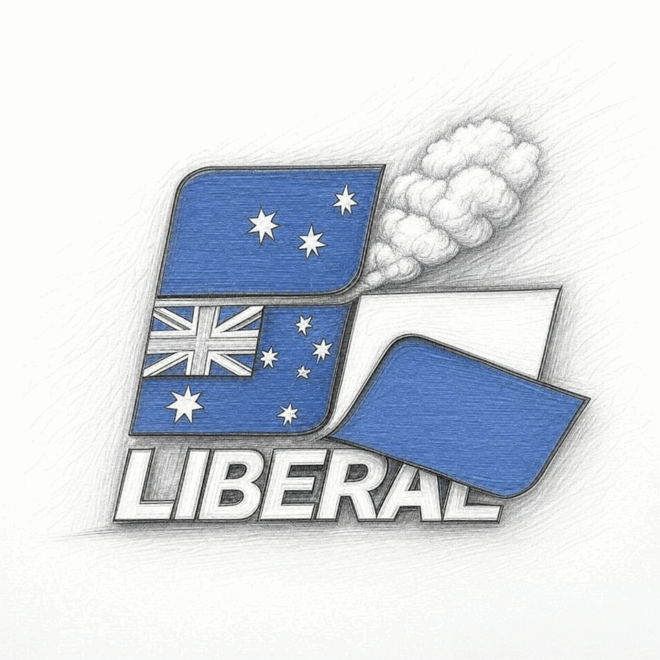
The Australian Liberal Party, a cornerstone of the nation’s political landscape, has become a focal point for intense scrutiny and debate. Critics often frame the party in two contrasting lights: as a nostalgic institution yearning for a mythical “golden age” of traditional values and economic stability or as a political apparatus designed to safeguard the wealth and privilege of Australia’s elite. While both perspectives carry significant weight, they do not entirely capture the complexity of the party’s motivations, policies and electoral strategies. This post delves into whether the Liberal Party is attempting to resurrect a bygone era, appealing to an older demographic increasingly disconnected from younger voters or whether it functions as a sophisticated front for billionaires and corporate interests, aiming to preserve their economic dominance.
The Nostalgia Narrative: A Party Rooted in a Bygone Age?
The assertion that the Liberal Party is mired in nostalgia stems from its frequent evocation of traditional values, economic conservatism and a vision of Australia reminiscent of the mid-20th century. This narrative suggests that the party is striving to persuade younger generations – those born after the so-called “golden age” of the 1950s to early 2000s – of the necessity to return to a time characterised by social cohesion, economic prosperity and cultural homogeneity. To explore this claim, we must analyse the party’s rhetoric, voter demographics and policy priorities.
Rhetorical Appeals to a Golden Age
The Liberal Party’s rhetoric often conjures a sense of nostalgia for a simpler, more stable Australia. During the tenure of Prime Minister John Howard (1996–2007), the party promoted policies emphasising family values, homeownership and a robust national identity steeped in Anglo-Australian traditions. Howard’s infamous assertion, “We will decide who comes to this country and the circumstances in which they come,” delivered in 2001, encapsulated a vision of Australia as a sovereign, culturally unified nation. This rhetoric resonated with older Australians who lived through the post-World War II economic boom and the relative social stability of the Menzies era (1949–1966), a period often romanticised as Australia’s golden age.
In contemporary politics, the Liberal Party continues to draw on similar themes. Leaders such as Scott Morrison (2018–2022) and Peter Dutton (2022–May 2025) have underscored “Australian values,” economic self-reliance and scepticism toward progressive social movements. Morrison’s 2019 election campaign heavily featured the image of the “quiet Australian” – a hardworking, suburban, family-oriented voter who values stability over radical change. This messaging implicitly contrasts the present with a past where such values were perceived as dominant, appealing to those feeling alienated by rapid social and cultural transformations, including increased immigration, multiculturalism and the rise of identity politics.
The Demographic Divide
The Liberal Party’s voter base further substantiates the nostalgia critique. Data from the 2022 federal election reveals a stark generational divide. According to the Australian Electoral Commission, 55% of the Liberal Party’s primary vote came from voters aged 55 and older, while only 15% came from those under 35. This disparity is significant when juxtaposed with the Australian Labor Party, which garnered 30% of its vote from the under-35 demographic. Younger voters, who have no memory of the Howard era, are more inclined to prioritise issues such as climate change, social equity and technological innovation – areas where the Liberal Party has often been criticised for falling short.
For instance, the Liberal Party’s climate policy has become a point of contention across generational lines. Its 2030 emissions reduction target of 26–28% below 2005 levels, established under the Paris Agreement, has been widely criticised as inadequate compared to Labor’s more ambitious 43% target. Polls conducted by the Lowy Institute in 2023 indicated that 70% of Australians aged 18–34 viewed climate change as a “critical threat,” in stark contrast to only 45% of those over 65. The party’s hesitance to embrace swift decarbonisation, alongside its defence of coal and gas industries, appears increasingly out of touch with a generation that does not share the same economic nostalgia.
Policy Priorities and the Past
The Liberal Party’s policy platform reinforces the perception that it is tethered to a bygone era. Its economic conservatism – rooted in small government, deregulation and tax cuts – draws heavily on the neoliberal principles championed in the 1980s and 1990s by figures like Margaret Thatcher and Ronald Reagan. In Australia, these ideas were institutionalised during the Hawke-Keating Labor governments but were solidified under Howard. The Liberal Party’s continued reliance on trickle-down economics, exemplified by the 2019 tax cuts that disproportionately benefited high-income earners, reflects a belief in outdated economic models. These policies resonate with older voters who associate them with the prosperity of the Howard years, a period marked by 11 years of uninterrupted economic growth.
Socially, the Liberal Party has been slow to embrace progressive reforms. Its opposition to the Indigenous Voice to Parliament in 2023, a referendum aimed at establishing an advisory body for Aboriginal and Torres Strait Islander peoples in the Constitution, was framed as a defence of “equality before the law.” Critics viewed this stance as a rejection of reconciliation and a nod to conservative voters resistant to acknowledging historical injustices. Similarly, the party’s ambivalence toward same-sex marriage (legalised in 2017 after a contentious postal survey) and its cautious approach to gender and identity issues suggest a worldview more aligned with past social norms.
The Limits of Nostalgia
While the nostalgia narrative possesses merit, it is not without its shortcomings. The Liberal Party’s appeal to traditional values and economic conservatism is not solely an attempt to resurrect the past but also a strategic effort to distinguish itself from Labor and the Greens, who dominate progressive and urban voter bases. By positioning itself as the party of stability and tradition, the Liberals aim to consolidate support among older, regional and suburban voters – a demographic that remains electorally significant. Moreover, the party has demonstrated some adaptability, such as embracing digital infrastructure investments and post-COVID economic recovery measures, indicating a pragmatic engagement with contemporary issues.
Nevertheless, the nostalgia critique gains traction because the Liberal Party’s vision often feels misaligned with the realities of a younger, more diverse Australia. The nation’s population is increasingly urban, multicultural and concerned with global challenges like climate change and technological disruption. By leaning on rhetoric and policies that evoke a pre-globalised, pre-digital era, the Liberal Party risks alienating voters who have no connection to the “golden age” it implicitly champions.
The Billionaire Cover Narrative: Protecting Wealth and Privilege?
In contrast, the alternative critique – that the Liberal Party serves as a front for billionaires and corporate interests – centres on its economic policies and ties to Australia’s elite. This perspective contends that the party’s free-market rhetoric and deregulation agenda are less about ideological purity and more about preserving the wealth and privilege of the top 1%. To evaluate this claim, we must scrutinise the party’s economic policies, their beneficiaries and the broader political economy.
Economic Policies and Wealth Concentration
Australia’s wealth distribution offers a crucial backdrop for this analysis. According to the 2023 Credit Suisse Global Wealth Report, the top 1% of Australians own 22% of the nation’s wealth, a concentration that has grown over the past two decades. The Liberal Party’s economic policies have often been criticised for exacerbating this inequality. Key examples include:
- Tax Cuts: The 2019 tax package, legislated under the Morrison government, flattened the tax rate for high-income earners, providing substantial benefits to the wealthy. By 2024, those earning over $200,000 were projected to receive annual tax savings of up to $9,075, while individuals earning $50,000 would see just $1,125. Critics argue that these cuts prioritise the affluent over the working class, contradicting the Liberal Party’s claims of supporting “aspirational” Australians.
- Negative Gearing and Capital Gains Tax Discounts: The Liberal Party has staunchly defended negative gearing, a tax concession that allows property investors to offset losses against their taxable income and the 50% capital gains tax discount established in 1999. These policies disproportionately benefit high-net-worth individuals, with 2021 Australian Taxation Office data indicating that 60% of negative gearing benefits accrued to the top 20% of income earners. The property market, a key driver of wealth accumulation, has become increasingly inaccessible to younger Australians, further fuelling perceptions of elite favouritism.
- Franking Credits: The Liberal Party’s defence of franking credits, which allow shareholders to offset tax on dividends, has been a contentious issue. In 2019, Labor’s proposal to limit franking credit refunds was fiercely opposed by the Liberals, who framed it as an attack on retirees. However, analysis by the Grattan Institute revealed that 80% of franking credit benefits accrued to the wealthiest 20% of households, undermining the “battler” narrative.
These policies align closely with the interests of Australia’s economic elite, particularly those in the property, finance and resource sectors. The Liberal Party’s rhetoric of “economic freedom” and “rewarding hard work” often obscures the structural advantages these policies confer on the already wealthy.
Ties to Corporate Interests
The Liberal Party’s relationship with corporate Australia further bolsters the billionaire cover narrative. The fossil fuel industry, a major economic player, has long enjoyed the party’s support. As the world’s second-largest coal exporter, Australia’s reluctance to phase out coal and gas aligns with the interests of mining giants such as BHP, Rio Tinto and Glencore. The 2023 Productivity Commission report noted that fossil fuel subsidies, including tax breaks and infrastructure support, cost taxpayers $11 billion annually, a policy sustained under Liberal governments.
Moreover, the revolving door between Liberal leadership and corporate boards raises questions about the party’s motivations. Former Liberal ministers, such as Joe Hockey and Mathias Cormann, have secured lucrative roles in finance and consulting firms after leaving politics, while others, like Andrew Robb, have joined companies with ties to the mining sector. These connections suggest a cozy relationship between the party and corporate elites, reinforcing perceptions that its policies are designed to protect wealth rather than promote broad-based prosperity.
The Defence: Economic Growth for All?
In response to these criticisms, the Liberal Party argues that its policies foster economic growth that benefits all Australians. During its tenure from 2013 to 2022, Australia maintained low unemployment (3.5% in 2023, among the lowest in the OECD) and strong GDP growth, averaging 2.5% annually prior to COVID. The party points to measures like the instant asset write-off for small businesses and JobKeeper, a $90 billion wage subsidy program during the pandemic, as evidence of its commitment to the broader economy.
Additionally, the Liberals contend that wealth creation at the top drives investment and job creation. Their support for deregulation and free trade, exemplified by agreements like the Australia–China Free Trade Agreement (2015), is framed as a rising tide that lifts all boats. The party also appeals to middle-class aspirants – small business owners, self-funded retirees and suburban homeowners – who perceive its policies as enabling their economic mobility, not solely that of billionaires.
The Limits of the Billionaire Cover Narrative
While the billionaire cover critique is compelling, it risks oversimplifying the Liberal Party’s motivations. Not all of its policies cater exclusively to the elite; many resonate with middle-class voters who value homeownership, superannuation and low taxes. The party’s electoral success – winning four of the last seven federal elections – indicates that it appeals to a broader coalition than just the ultra-wealthy. Furthermore, wealth-friendly policies are not unique to the Liberals; Labor has also maintained negative gearing and capital gains tax discounts, reflecting the political difficulty of reforming entrenched systems.
Nevertheless, the perception of elite bias persists because the Liberal Party’s policies consistently prioritise wealth preservation over redistribution. Its resistance to structural reforms, such as a wealth tax or increased social spending, aligns with the interests of Australia’s economic elite, even if couched in broader economic arguments.
A Synthesis: Ideological Inertia Meets Strategic Alignment
The actions of the Liberal Party cannot be distilled into nostalgia or elitism alone; they reflect a complex interplay of ideological inertia and strategic alignment with powerful interests. The party’s nostalgic rhetoric and conservative policies resonate with older, wealthier voters who fondly remember the stability of the Howard years. This ideological commitment to tradition and neoliberal economics creates a feedback loop, reinforcing policies that prioritise stability over innovation and wealth preservation over equitable reform.
Simultaneously, the Liberal Party’s alignment with corporate and elite interests is not merely incidental but a deliberate strategy to maintain political and economic power. By championing deregulation, tax cuts and fossil fuel industries, the party secures financial and political support from Australia’s wealthiest individuals and corporations. This alignment is not conspiratorial but structural, embedded in the party’s funding networks, policy priorities and post-political career paths.
The tension between these two dynamics – nostalgia and elitism – poses a challenge for the Liberal Party in an Australia that is rapidly evolving. Younger voters, who are more diverse, urban and concerned with climate and equity, find little appeal in a party that evokes a past they never experienced. Meanwhile, the party’s economic policies, while beneficial to the wealthy, struggle to address the mounting cost-of-living pressures facing the middle and working classes. The 2022 election, where the Liberals lost key urban seats to Labor and independent “teal” candidates, underscored this disconnect.
Conclusion
The Australian Liberal Party is neither wholly a relic of a bygone age nor merely a front for billionaire privilege; it is a political entity shaped by both tendencies. Its nostalgic rhetoric and conservative policies reflect an ideological commitment to a vision of Australia that resonates with older, wealthier voters, often at the expense of younger generations. Simultaneously, its economic agenda closely aligns with the interests of Australia’s elite, prioritising wealth preservation over equitable reform. These dual impulses – ideological inertia and strategic elitism – create a party that struggles to adapt to a changing electorate, caught between the allure of a mythologised past and the demands of a privileged present. As Australia grapples with climate change, inequality and cultural diversity, the Liberal Party’s ability to reconcile these tensions will determine its relevance in the decades to come.


